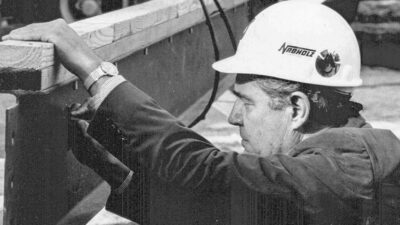What is firestopping?
Firestopping is a crucial step towards making buildings safe for inhabitants. It mitigates damages and saves lives if a fire ever occurs. Designers employ three main fire-stopping strategies when first designing a new building.
The first strategy comes into play when picking building materials specifically designed to burn slower. The second strategy involves installing some sort of fire protection system, such as automatic water sprinklers or automatic suppression systems. The third strategy focuses on compartmentalization or passive protection, which delay or prevents fire from spreading. This third strategy is what Nabholz’ firestop specialty contractor unit concentrates on.
What does Nabholz do?
Passive protection involves sealing up any wall penetrations or joints in the fire-rated walls, and begins when the construction work on the building is almost complete. Nabholz craftsmen certified in firestopping enter the building around the same time as the painters—after all the other trades have finished their work. The crew then meticulously combs through the building, sealing any wall penetrations or joints left behind by the other trades, like plumbing and electrical, with caulk, wool, or spray materials.
This work takes planning. Passive protection and compartmentalization relies on precision and attention. Nabholz’ firestopping professionals analyze plans from architects, engineers, and various subcontractors to determine where firestopping will be needed, as well as what rating the firestopping must achieve to meet the designer’s specifications.
Our crew must consider many different factors. Different types of wall materials require different types of fire stopping. Firestopping methods could change based on the size of the wall penetration. Our work and materials must match the rating on the designer’s plans for flame ratings, thermal ratings, and smoke ratings.
Can Nabholz perform firestopping work in buildings after occupation?
Our crew can also go back into a building after occupation and perform firestopping updates. For example, if a hospital client has occupied the building and made any sort of change to the plumbing or electrical by remodeling rooms, our team can look at the master set of drawings, identify which walls are firewalls, and bring any compromised walls back up to standards.
We also have the ability to work side-by-side with contractors that routinely break through existing walls, like HVAC and mechanical systems installers, to ensure that their work does not compromise firewalls. By working with a firestop specialty contractor like Nabholz, these trades can concentrate solely on their installations while our certified craftsmen perform any necessary firestopping.
Are we certified?
Of course, this kind of work takes training. Our craftsmen go through the Firestop Specialty Contractor Program at Hilti, which trains professional fire protection systems installers to use Hilti products that meet all current standards and codes. Nabholz currently has 13 team members with this certification and can perform firestopping throughout Arkansas, Oklahoma, Missouri, and Kansas.
Above all, firestopping reduces liability and risk in the case of the fire. When properly planned and thoroughly executed, firstopping gives owners peace of mind, and keeps employees and clients safe.

